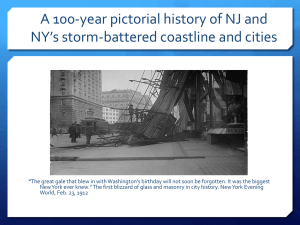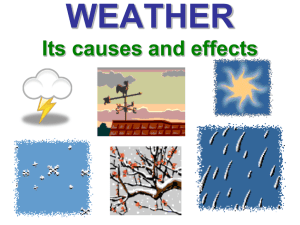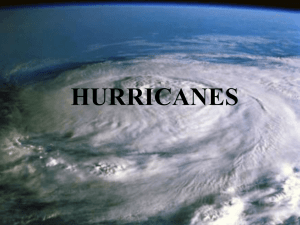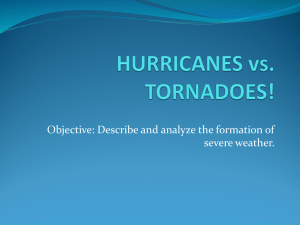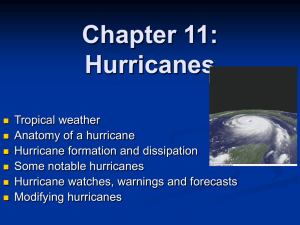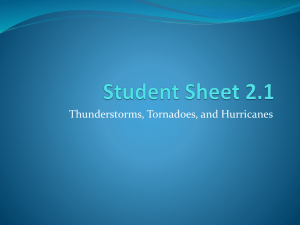Introduction
advertisement
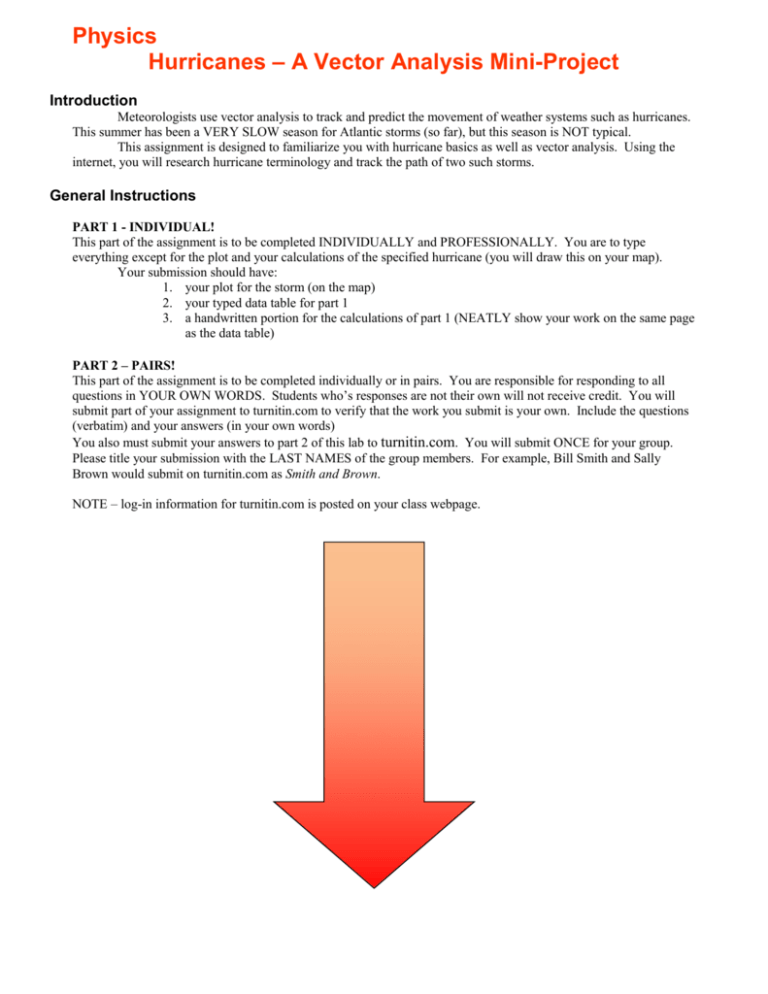
Physics Hurricanes – A Vector Analysis Mini-Project Introduction Meteorologists use vector analysis to track and predict the movement of weather systems such as hurricanes. This summer has been a VERY SLOW season for Atlantic storms (so far), but this season is NOT typical. This assignment is designed to familiarize you with hurricane basics as well as vector analysis. Using the internet, you will research hurricane terminology and track the path of two such storms. General Instructions PART 1 - INDIVIDUAL! This part of the assignment is to be completed INDIVIDUALLY and PROFESSIONALLY. You are to type everything except for the plot and your calculations of the specified hurricane (you will draw this on your map). Your submission should have: 1. your plot for the storm (on the map) 2. your typed data table for part 1 3. a handwritten portion for the calculations of part 1 (NEATLY show your work on the same page as the data table) PART 2 – PAIRS! This part of the assignment is to be completed individually or in pairs. You are responsible for responding to all questions in YOUR OWN WORDS. Students who’s responses are not their own will not receive credit. You will submit part of your assignment to turnitin.com to verify that the work you submit is your own. Include the questions (verbatim) and your answers (in your own words) You also must submit your answers to part 2 of this lab to turnitin.com. You will submit ONCE for your group. Please title your submission with the LAST NAMES of the group members. For example, Bill Smith and Sally Brown would submit on turnitin.com as Smith and Brown. NOTE – log-in information for turnitin.com is posted on your class webpage. Hurricane Archives Part 1 - Vector Analysis of Hurricanes 1. Connect to the Internet and go to the following address: http://www.wunderground.com/tropical/ (This is a great site for tracking tropical systems.) Just below the heading Tropical Weather there is a link for Hurricane Archives – click this link. 2. Scroll down to the middle of the page and find the section labeled “Hurricane Archives.” Click on “2005.” You will be linked to a page that shows a graphic and a table of all of the hurricanes of the 2005 season. This map shows the paths of all of the 2005 hurricanes… You want to look down below to link to Katrina. Click for Hurricane Katrina Information Archive 3. You will be analyzing the year’s most devastating storm, Hurricane Katrina. Click on the link to Hurricane Katrina and follow the instructions below. If you are in the right place, you will see a plot of Katrina’s motion and (below that) a data table of storm coordinates. Once you have plotted the path of Hurricane Katrina, you can convert your final displacements into miles. The approximate conversions are: 1°Latitude = 69.04 miles 1°Longitude = 59.96 miles 1. On the class web page there is a WORD document with a blank data table. In this data table, record the latitude and longitude of Hurricane Katrina at the specified dates and times. Be sure to periodically SAVE this document onto the network or a USB drive. 2. Print the tracking map at the end of this document*, plot the position coordinates (using the data you recorded in step 1) for Katrina. HINT: Plot data points, and then use displacement vectors (arrows) to show the hurricane’s path. This should be TO SCALE! Also, use a different colored pencil for each storm category of Katrina (for example when it was a Category 1 plot in blue, when it was a category 2 plot in red…be sure to include a key.) * there is also a tracking map in the back of your packet. 3. Determine the change in the latitude (Δy: north-south) and longitude (Δx: eastwest). Give these values in degrees (latitude and longitude) as well as in miles. Use these values to determine the net displacement of Hurricane Katrina. 4. Calculate the net velocity Hurricane Katrina? Show your work (in the space beneath the data table). Part 2 - Understanding Hurricanes 1. Connect to the internet and go to the following address: http://www.nhc.noaa.gov/ (This is the site for the national hurricane center through NOAA- the National Oceanic and Atmospheric Administration.) 2. Using the information and links provided by the NOAA website, answer (in your own words) the following questions. Please type each question followed by your answer. The information you seek is in the “Outreach and Education” section. If you use a resource other than the National Hurricane Center’s website you MUST SITE YOUR REFERNCE!!!) QUESTIONS 1. What is a hurricane? In what part of the world are hurricanes formed? 2. What is the difference between a hurricane watch and a hurricane warning? ii. 3. Atlantic Hurricanes are rated using what scale? Name the scale and describe each level. 4. Using one of the websites provided in this min-project or on another website, discover if there are any tropical disturbances (currently) in the North Atlantic. If so, what are they? (They may be numbered not named). Site your source. 70 degrees longitude 80 60 50 20 90 30 100 Hurricane Tracking Map 40 10 Degrees Latiitude Why Hurricanes? Aside from the fact that all science is tied together and that the motion of a hurricane is perfect for vector analysis, Mrs. Klein loves weather! Even as a child, her family couldn't keep her inside during a storm…even a hurricane. Photos of Mrs. Klein and her family during Hurricane Charley That’s Mrs. Klein being blown around by Charley’s winds. Actually these pictures were taken just as the eye of the storm was moving overhead so the winds and the rain were minimal at this time. The streets were flooded due to heavy rains. Because this was in the Outer Banks all of the houses were elevated on stilts – we could actually feel the house sway significantly when the wind was blowing. NOTE – If you are ever in a tropical storm, hurricane or ANY weather emergency situation, seek shelter immediately and follow ALL warnings/emergency instructions!
